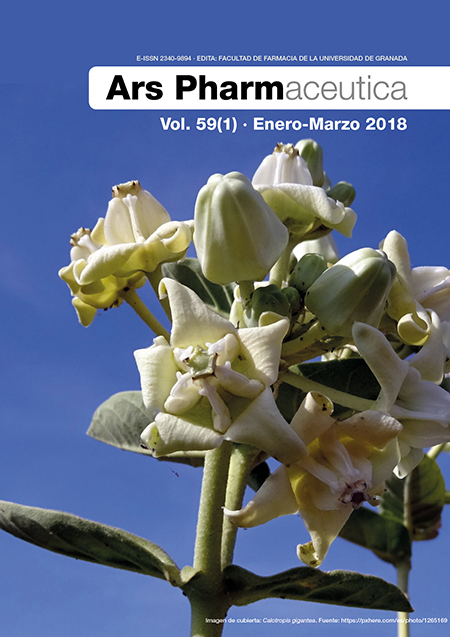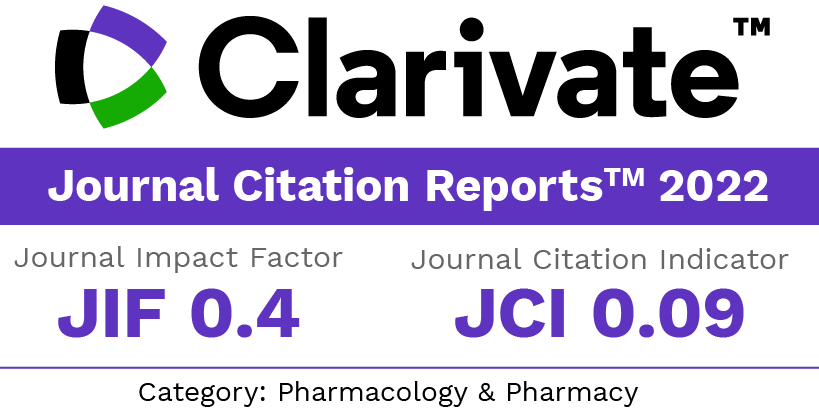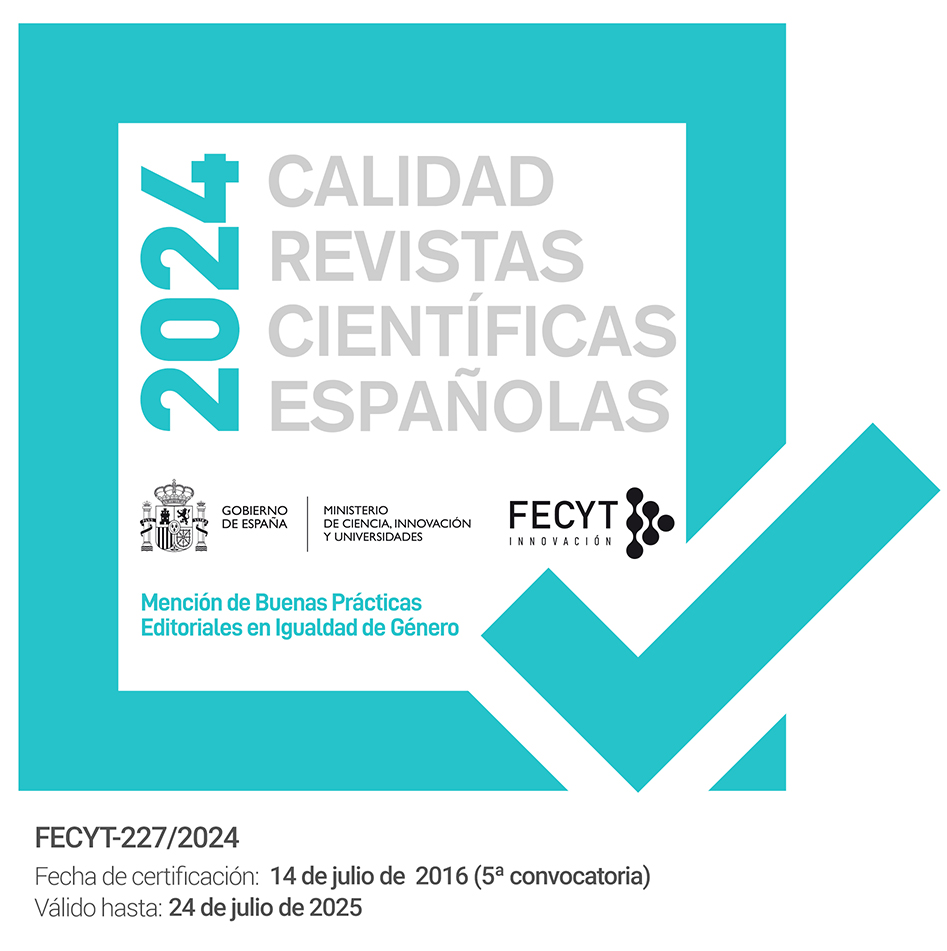Development and characterization of a novel nano-liposomal formulation of Alendronate Sodium loaded with biodegradable polymer
DOI:
https://doi.org/10.30827/ars.v59i1.7274Keywords:
Liposome, Alendronate Sodium, starch, Ulcerogenicity studiesAbstract
Background: Alendronate Sodium (ALDS) is the drug of choice for treatment of osteoporosis. However, 50% of the osteoporotic patients ceased the treatment within the first year due to its potential side effect on the gastrointestinal tract (GIT).
Objective: The current study aimed to utilize nanotechnology to develop a nano-oral liposomal preparation containing biodegradable polymer (Starch) that enhance the drug prosperities.
Methods: Nanoliposomes of ALDS were prepared using different concentrations of solubilized starch (0.1 - 0.5 g ) by thin film hydration method. A new method of alendronate quantitative determination was used to overcome the obstacle of its determination by using a new highly sensitive derivatization method. The selected formula was visualized using TEM, in vitro release studies and Stability study was also carried out.
Furthermore, ulcerogenicity studies were performed to compare between the optimum prepared formula and a standard nonliposomal ALDS.
Results: Six nano-oral liposomal formulations were prepared with zeta potentials ranging from -12 mV to -39 mV and a particle size ranging from 94 nm to 298 nm. The encapsulation efficiency studies demonstrated that the amount of ALDS entrapped within liposomes increased with increasing starch concentration. The stability studies confirmed the role of starch in increasing the stability of the prepared liposomes. In vitro release studies have demonstrated a relative delay in ALDS releases from the liposome core.
Ulcerogenicity studies proofed that the prepared formula has a significant gastric tolerance.
Conclusion: a novel liposomal formula of ALDS was developed with better tolerability. However, further clinical investigations are necessary to evaluate its therapeutic effectiveness.
Downloads
References
Iyer RN, Purohit V, Karankumar J, Ahluwalia AK. Assessment of efficacy, safety and quality of life in postmenopausal women with osteoporosis using salmon calcitonin nasal spray. Asian J Pharm Clin Res. 2013;6(2):117-9.
Ochiuz L, Peris J-E. Preparation and characterisation of alendronate-loaded chitosan microparticles obtained through the spray drying technique. Medicinal chemistry. 2009;5(2):191-6.
Han H-K, Shin H-J, Ha DH. Improved oral bioavailability of alendronate via the mucoadhesive liposomal delivery system. European Journal of Pharmaceutical Sciences. 2012;46(5):500-7.
Kuljanin J, Janković I, Nedeljković J, Prstojević D, Marinković V. Spectrophotometric determination of alendronate in pharmaceutical formulations via complex formation with Fe (III) ions. Journal of pharmaceutical and biomedical analysis. 2002;28(6):1215-20.
Maurer N, Wong KF, Stark H, Louie L, McIntosh D, Wong T, et al.. Spontaneous entrapment of polynucleotides upon electrostatic interaction with ethanol-destabilized cationic liposomes. Biophysical Journal. 2001;80(5):2310-26.
Law S, Huang K, Chiang C. Acyclovir-containing liposomes for potential ocular delivery: corneal penetration and absorption. Journal of controlled release. 2000;63(1):135-40.
Saritha K, Saraswathi U, Singaravelu G, Revathi S, Jayanthi V. Biological synthesis and characterization of gold nanoparticles using Lemna minor. Asian J Pharm Clin Res. 2014;7(2):165-7.
Bodnar M, Hartmann JF, Borbely J. Preparation and characterization of chitosan-based nanoparticles. Biomacromolecules. 2005;6(5):2521-7.
Namazi H, Fathi F, Heydari A. Nanoparticles based on modified polysaccharides. The delivery of nanoparticles: InTech; 2012.
Ochubiojo EM, Rodrigues A. Starch: from food to medicine: INTECH Open Access Publisher; 2012.
Haidar ZS, Tabrizian M. Core–shell polymeric nanomaterials and their biomedical applications. Nanotechnologies for the Life Sciences. 2011.
Te Wierik G, Eissens A, Bergsma J, Arends-Scholte A, Bolhuis G. A new generation starch product as excipient in pharmaceutical tablets: III. Parameters affecting controlled drug release from tablets based on high surface area retrograded pregelatinized potato starch. International journal of pharmaceutics. 1997;157(2):181-7.
Van Beynum GMA, Roels J. Starch conversion technology. 1985.
Simi C, Abraham TE. Hydrophobic grafted and cross-linked starch nanoparticles for drug delivery. Bioprocess and biosystems engineering. 2007;30(3):173-80.
Brandi ML, Black D. A drinkable formulation of alendronate: potential to increase compliance and decrease upper GI irritation. Clinical Cases in Mineral and Bone Metabolism. 2013;10(3):187.
Gupta VK, Jain R, Sharma S, Agarwal S, Dwivedi A. Quantitative determination of alendronate in human urine. Int J Electrochem Sc. 2012;7:569-87.
Ezzati Nazhad Dolatabadi J, Hamishehkar H, de la Guardia M, Valizadeh H. A fast and simple spectrofluorometric method for the determination of alendronate sodium in pharmaceuticals. Bioimpacts. 2014;4(1).
Dua J, Rana A, Bhandari A. Liposome: methods of preparation and applications. Int J Pharm Stud Res. 2012;3(2):14-20.
Shenyang Pharmaceutical University soDoP. LABORATORY 10: Preparation of liposomes and determination of encapsulation efficiency 2014.
Sultana S, Talegaonkar S, Mittal G, Bhatnagar A, Ahmad FJ. Determination of Alendronate Sodium by Box-Behnken Statistical Design. Chromatographia. 2010;72(3-4):321-6.
Dolatabadi JEN, Hamishehkar H, de la Guardia M, Valizadeh H. A fast and simple spectrofluorometric method for the determination of alendronate sodium in pharmaceuticals. BioImpacts. 2014;4(1):39.
Nahar K, Absar S, Patel B, Ahsan F. Starch-coated magnetic liposomes as an inhalable carrier for accumulation of fasudil in the pulmonary vasculature. International journal of pharmaceutics. 2014;464(1):185-95.
Mady MM, Darwish MM. Effect of chitosan coating on the characteristics of DPPC liposomes. Journal of Advanced Research. 2010;1(3):187-91.
Hosny KM, Ahmed OAA, Al-Abdali RT. Enteric-coated alendronate sodium nanoliposomes: a novel formula to overcome barriers for the treatment of osteoporosis. Expert opinion on drug delivery. 2013;10(6):741-6.
Wissing S, Kayser O, Müller R. Solid lipid nanoparticles for parenteral drug delivery. Advanced drug delivery reviews. 2004;56(9):1257-72.
Abdelbary A, Salem HF, Khallaf RA, Ali AM. Mucoadhesive niosomal in situ gel for ocular tissue targeting: in vitro and in vivo evaluation of lomefloxacin hydrochloride. Pharmaceutical Development and Technology. 2017;22(3):409-17.
Bai S, Ahsan F. Inhalable liposomes of low molecular weight heparin for the treatment of venous thromboembolism. Journal of pharmaceutical sciences. 2010;99(11):4554-64.
Guo J-x, Ping Q-n, Jiang G, Huang L, Tong Y. Chitosan-coated liposomes: characterization and interaction with leuprolide. International journal of pharmaceutics. 2003;260(2):167-73.
Torchilin VP. Recent advances with liposomes as pharmaceutical carriers. Nature reviews Drug discovery. 2005;4(2):145-60.
Soehngen EC, Godin‐Ostro E, Fielder FG, Ginsberg RS, Slusher MA, Weiner AL. Encapsulation of indomethacin in liposomes provides protection against both gastric and intestinal ulceration when orally administered to rats. Arthritis & Rheumatism. 1988;31(3):414-22.
Fukui T, Kawaguchi AT, Takekoshi S, Miyasaka M, Tanaka R. Liposome-Encapsulated Hemoglobin Accelerates Skin Wound Healing in Mice. Artificial organs. 2012;36(2):161-9.
Topping DL, Fukushima M, Bird AR. Resistant starch as a prebiotic and synbiotic: state of the art. The Proceedings of the Nutrition Society. 2003;62(1):171.
Bateman D. Effects of meal temperature and volume on the emptying of liquid from the human stomach. The Journal of physiology. 1982;331:461.
Bosaeus I. Fibre effects on intestinal functions (diarrhoea, constipation and irritable bowel syndrome). Clinical Nutrition Supplements. 2004;1(2):33-8.
Peter C, Handt L, Smith S. Esophageal irritation due to alendronate sodium tablets (possible mechanisms). Digestive diseases and sciences. 1998;43(9):1998-2002.
Downloads
Published
How to Cite
Issue
Section
License
The articles, which are published in this journal, are subject to the following terms in relation to the rights of patrimonial or exploitation:
- The authors will keep their copyright and guarantee to the journal the right of first publication of their work, which will be distributed with a Creative Commons BY-NC-SA 4.0 license that allows third parties to reuse the work whenever its author, quote the original source and do not make commercial use of it.
b. The authors may adopt other non-exclusive licensing agreements for the distribution of the published version of the work (e.g., deposit it in an institutional telematic file or publish it in a monographic volume) provided that the original source of its publication is indicated.
c. Authors are allowed and advised to disseminate their work through the Internet (e.g. in institutional repositories or on their website) before and during the submission process, which can produce interesting exchanges and increase citations of the published work. (See The effect of open access).























